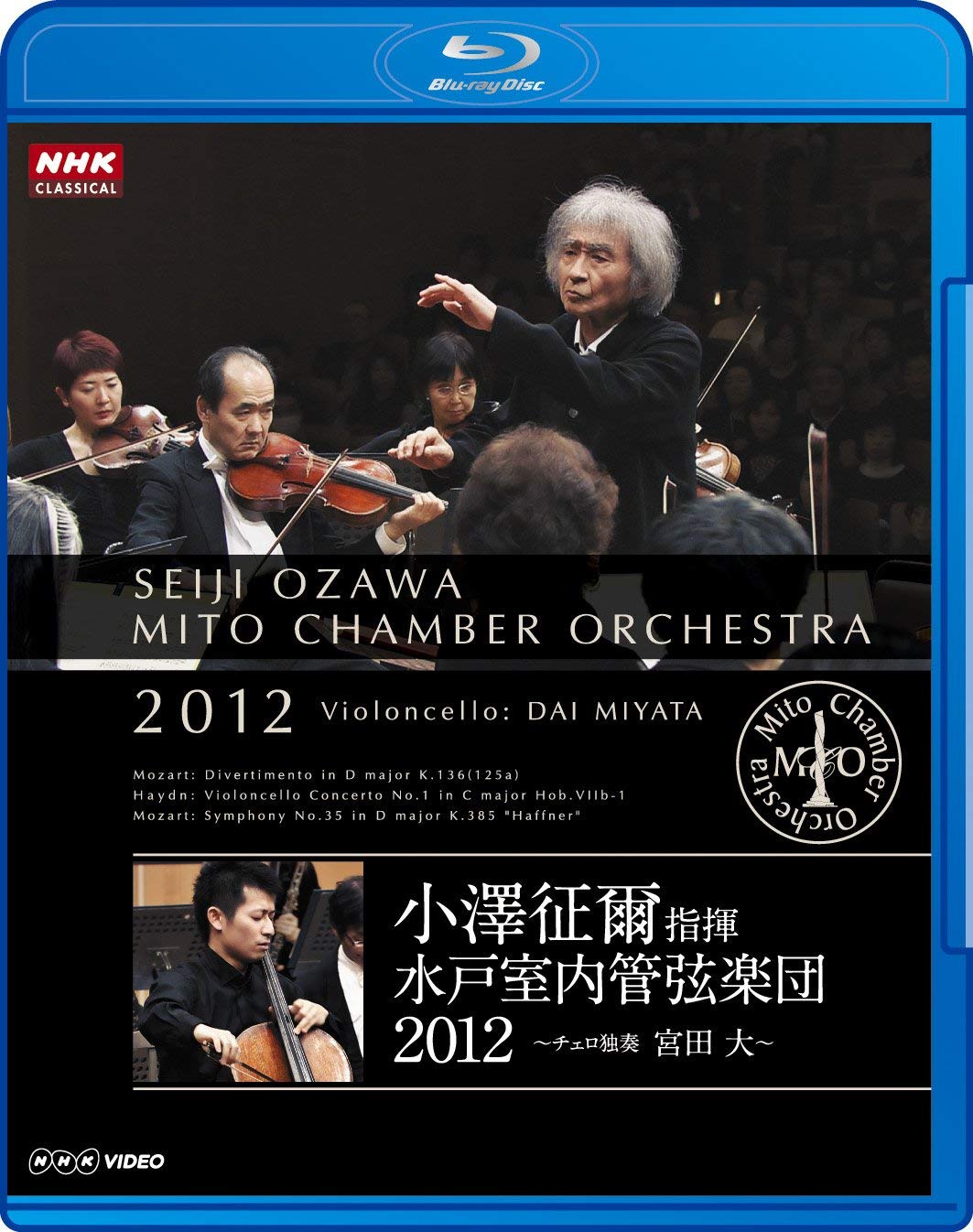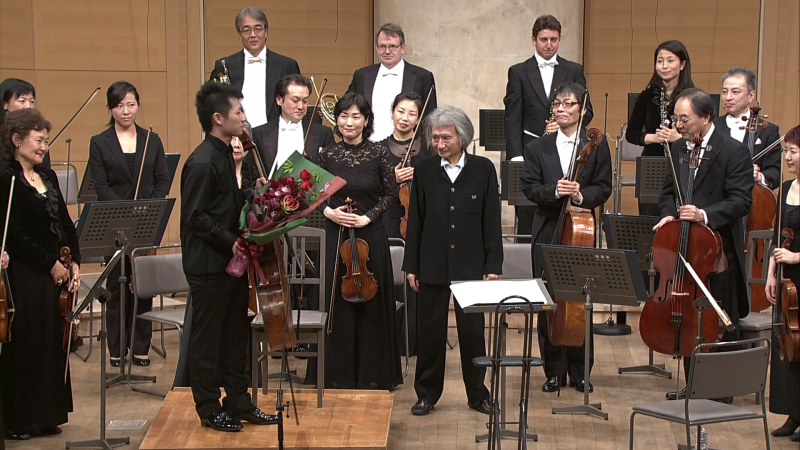Mozart Symphony No. 35 & Haydn Cello Concerto No. 1. In 2012 Seiji Ozawa conducted the Mito Chamber Orchestra in Mito, Japan at the Art Tower Mito (ATM). The program:
Mozart Divertimento in D major K.136
Haydn Cello Concerto No.1 with soloist Dai Miyata
Mozart Symphony No. 35 "Haffner"
Released 2012, disc has the following sound on all tracks: (1) Stereo 2.0 PCM 96kHz/24bit (2) 5.0 PCM 96kHz/24bit and (3) 5.0 Dolby Digital 48kHz. Directed for TV by Goro Kobayashi and Masami Utsimi; Technical Directors were Kiyotaka Aoki and Satoru Fukuda; Switcher was Hiroshi Minegishi; Camera by Fumio Saito; Sound by Ryota Ono; Video Engineer was Shoichiro Ogawa. Grade: A+
The recorded sound quality for all three items on the program is superb. In the Divertimento with its small number of 22 strings, I can often distinctly hear the sections separately when they are playing together. Fast runs are extremely clean and accurate. The small forces used do not produce a lot of air pressure, but with the close and accurate recording, I notice a surprisingly large dynamic range even in the Divertimento. The producers can be proud of providing their customers with state-of-the-art sound for a classical HDVD.
The PQ was excellent throughout this well-lit program even if the resolution was slightly soft. I discuss picture content separately for each number on the program.
Divertimento in D Major
This warm-up piece of about 12 minutes has 22 players and is conducted by the concertmaster. The performance is neat and satisfying. I count 65 video cuts for a stately viewing pace of about 11 seconds for the average cut. Almost half of the cuts show the whole ensemble or most of it or multiple sections. It is nice to see a symphony group play without a conductor in the way, and there are few errors (one instrument-only shot and a bit of fussy panning about). So this segment qualifies for an A+.
Here's a shot of the whole group playing the Divertimento:
Below is the concert master for this piece. There were 13 violins in the Mito Chamber Orchestra in 2012. I get the impression that all of them play 1st and 2nd violin as required and that many if not all of them might take on the role of section leader from time to time. In this video, you can easily see that the violins are configured differently in each number:
There are many familiar faces from the Saito Kinen recordings. Below we see the cellos, violas, and 2 bass violins:”
Haydn Cello Concerto No. 1
The main event in this title is the Haydn concerto. It's longer than the Mozart symphony and gives a member of the cello section a chance to show off. The chance this year went to young Dai Miyata. He is listed in the keepcase booklet as the last member of the cello section. I guess this means that any member of the Mito Chamber Orchestra could be called on to be soloist, i.e., they are all that good. Or maybe this is an initiation for a new member of the section. At any rate, Miyata was definitely fired up and his success was a source of joy for all the musicians. And because this was recorded in high-definition TV, you get the share in this joy as well—this is the kind of information you can't get from a CD.
For the concerto, the orchestra is up to 27 players including the soloist:
Miyata is an intense guy:
Ozawa was at this time only about 76, but he had had serious health problems. Here he uses a chair to rest part time (some weeks after this concert Ozawa announced he would take a year off from conducting to rest):
Still perched on the edge of the chair, Osawa is right in Miyata's face, imploring him to dig deeper:
Miyata complies:
Here's an instrument-only shot that makes sense as part of an extensive video of a solo performer:
But this is just a lazy way for a cameraman to catch his breath:
And we do not want shots like this diluting the soloist's fervent efforts:
Miyata nails his performance and an almost raucous celebration (for a chamber orchestra) breaks out:
Note the flower arrangement. The Japanese do not give flowers wrapped in horrible cellophane. The flowers are presented in a hand-crafted paper cradle made with colors matching the flowers chosen by the donor:
The Haydn concerto has it all: a fine and exciting performance with all but perfect SQ and PQ. 57% of the 89 video cuts show the soloist, the whole orchestra, or most of the orchestra. The average cut lasts for a luxurious 17 seconds insuring that the viewer has plenty of time to enjoy the show and savor the event unfolding on the HT screen. So I give this segment a grade of A+.
Mozart Symphony No. 35
Now the band is up to 36 players:
An attempt to shoot everybody other than the strings:
Here's the best shot on the disc of the lead 1st and 2nd violins:
More winds:
Now for a few problem areas. The shot below appears quite a few times. It's off-balance. I think they set up a camera in the back to get a good 95% whole-orchestra view and locked the camera to the tripod. But then somebody came along and bumped the tripod:
And, oh dear, there are about 10 shots like this in this number!
Even though Ozawa is ailing, he works the room after the performance better that Bill Clinton at a Miss Universe pageant:
Japanese musicians bow a lot to the main audience. Then they turn around and bow to the spectators behind the stage in the chorus galleries!
The quality of the video for the symphony is similar to the earlier segments except for video content. There are 113 cuts in the symphony video and only about 35% of these involve large-scale views. There are too many conductor shots and too much zooming in and out. On the other hand, the average cut lasts 11 seconds, which is reasonably relaxed. I don't want to be too critical. I say the video content here shows signs of "pre-"DVDitis." I therefore wind up with a grade of A- for this segment.
[Special note. Later, I ran the numbers on this Mozart S35 and did a Wonk Worksheet. The WW sheet and our new 3 tests for DVDitis confirm this glowing review I made back in 2013. Sadly, few folks other than NHK have made high-quality classical music video recordings. The industry seems still appears to be stuck in the DVD rut.]
So what should the grade for this title be overall? We have A+ for the Divertimento, A+ for the concerto, and an A-. That's better than a A, so I give the whole title an A+.























